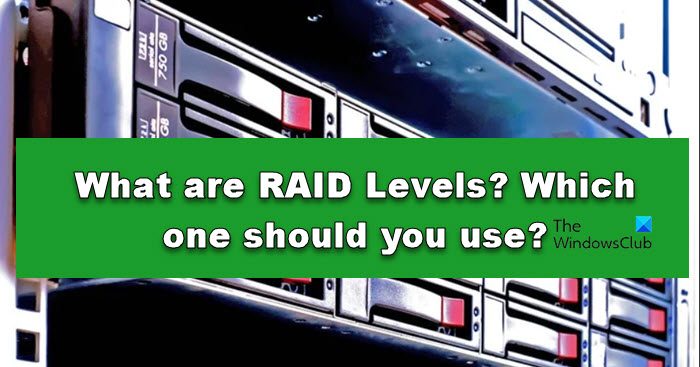In the world of data storage, there’s quite a curiosity about RAID. Many users are confused and curious about adding this tool to their artillery but are unsure about this decision. A Redundant Array of Independent Disks configuration (RAID) can be considered as a solution for users who want speed as well as security. In this article, we’ll delve into RAID, learn what are Raid levels, and find out which one we should use.

What is RAID?
In simple layman’s terms, RAID is a technology that allows users to combine multiple physical disk drives into a single unit. This improves data storage performance and reliability, enhances data protection against drive failures, and increases I/O performance. It’s a necessary thing in an environment where data integrity and availability are critical.
All the above is done by devising techniques like data striping, mirroring, and party to achieve this objective. There are different levels of RAID, from common RAID 0 to RAID 10, each with its own advantages and trade-offs. In the next section, we will learn about different RAID levels and which one to use.
What are the different RAID Levels?

There are different levels of RAID, and some of the common ones are mentioned below:
- RAID 0 (Striping)
- RAID 1 (Mirroring)
- RAID 2, 3, 4 (Bit-level Striping with parity)
- RAID 5 (Block-level Striping with distributed parity)
- RAID 6 (Block-level Striping with dual parity)
- RAID 10 (Striping with mirroring)
- RAID 50 (Striping + Distributed Parity)
Let’s dive into it.
1] RAID 0
RAID 0 devices the method of striping to increase read and write speed. Striping is the method where the data is broken down into smaller segments called Stripes, and stored equally across the multiple hard drives. However, one critical aspect to note is the lack of redundancy. If one drive fails, users can expect their entire RAID array to be compromised, resulting in potential data loss.
Therefore, it is always recommended to use Striping with other RAID levels that introduce Redundance to ensure data protection and fault tolerance.
2] RAID 1
RAID 1 is quite known for its data-protecting capabilities via its mirroring technique. By this, we mean that the same data is stored, or mirrored on two different drives. Every piece of data written to one drive is simultaneously written to another drive, creating an exact copy (mirror) of the entire dataset. In this way, the failure of one drive does not result in the loss of data or system downtime. However, it’s necessary to keep in mind that RAID 1 does not provide write performance as high as RAID levels that focus on striping. In addition to it, it also needs to occupy half the storage for duplicating the data.
3] RAID 2,3,4
RAID 2, 3, and 4 are some of the lesser-known RAID levels with distinct features. RAID 2 is known data is bit-level striped with hamming code ECC [Error Correcting Code], where data is bit-level striped (divided into individual bits) across multiple devices. whereas RAID 3 and RAID 4 are known for byte-level and block-level striping with parity respectively.
RAID 2 is used for its high data accuracy, however, not used widely due to the complexity of implementing Hamming code at the bit level. Whereas, RAID 3 is suitable for apps that involve large sequential data transfer, such as video editing or streaming apps. Again not used in common practices due to limitations in random I/O performance and the dedicated parity drive becoming a potential bottleneck. Last but not least, RAID 4 is suitable for certain database or file server workloads. However, like the other two, less commonly used due to better options provided by other RAID levels.
4] RAID 5
RAID 5 is known for its balance between performance and data redundancy. It devices striping with parity to enhance data access speed and introduces parity protection for error detection and correction. This level is known for tolerating the failure of a single drive without losing data, allowing for the reconstruction of missing data.
Here, data is not mirrored but rather distributed with the parity information across all the drives. RAID 5 generally offers a good deal, however, it has its own drawbacks such as write performance, rebuilding time, and Array size limitations as it requires at least 3 devices.
5] RAID 6
RAID 6 is a highly advanced RAID configuration, and is specifically known for its advanced data protection and fault tolerance. Here, dual parity is used, which calculates and stores data in two parity information for each set of data stripes. This allows the array to tolerate the simultaneous failure of two drives without losing data.
Fault tolerance is treated in RAID 6 as compared to RAID 5 because of the same feature. It is also designed in such a way that it prioritizes data integrity and protection, however, at the cost of slightly reduced write performance.
6] RAID 10
RAID 10 can be called one of the most widely RAID levels, also known as RAID 1+0. This is because of its combination of features that provide both high performance and robust data redundancy. Users can expect high read and write performance with data mirrored on separate devices. The best part of RAID 10 is that it can withstand the failure of multiple devices as long as they are not part of the same mirrored pair.
The only drawback that this level of RAID has is the cost of using more disk space for mirroring. It may require a larger number of drives compared to other RAID levels.
Which RAID should I use?
The choice of which RAID level to use depends on needs and preferences. Let’s see some considerations:
- RAID 0: If performance, as in increased read and write performance, is prioritized over data redundancy, as failure of one drive can lead to all data lost.
- RAID 1: If data redundancy and fault tolerance are top priority.
- RAID 5: If you want a balance between performance and data redundancy. Lower write performance, however, can tolerate the failure of a single drive without data loss.
- RAID 10, RAID 1+0: If high performance and data redundancy are the utmost priority. Requires more drive, hence the cost is high.
- RAID 50 AND 60: If needed in an environment that requires a combination of distributed parity or dual parity; however, sometimes, it can get complicated to set this up.
That’s it!
Read: Software RAID vs Hardware RAID – Differences explained
What are the benefits of using RAID?
RAID (Random Array of Independent disks) is known for providing data redundancy, improved read and write performance increased storage capacity, and data integrity. RAID levels like RAID 1, RAID 5, RAID 6, and RAID 10 provide redundant copies on other devices, ensuring data continuity even if a drive fails.
Read: How to create Mirrored Volume for Instant Hard Drive Backup in Windows?
What is the best RAID level for performance?
When considering the performance aspect, RAID 0 and RAID 10 are the most selected levels by users. RAID 0 provides striping whereas RAID 10 provides stripping + mirroring. The former can be a risky choice due to the high chances of data loss, whereas the latter can handle it.
Also Read: Best free RAID software for Windows.
Leave a Reply